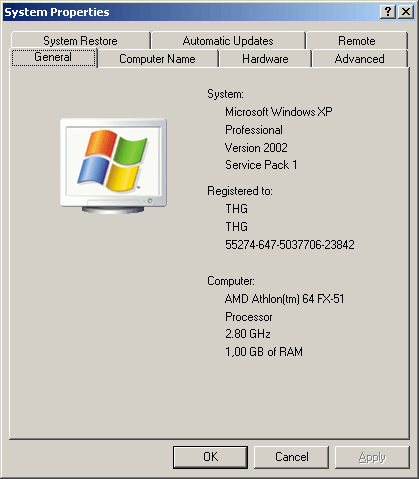The Athlon Cooler Cometh at 2.8 GHz and Below Zero Cool
Test Procedure And Special Aspects
| Intel Processors (Socket 478) | |
|---|---|
| 200 MHz FSB (Dual DDR400) | Pentium 4 3.20 GHz (3200 MHz 12-8/512 kB)Pentium 4 3.00 GHz (3000 MHz 12-8/512 kB)Pentium 4 2.80 GHz (2800 MHz 12-8/512 kB)Pentium 4 2.60 GHz (2600 MHz 12-8/512 kB)Pentium 4 2.40 GHz (2400 MHz 12-8/512 kB) |
| 133 MHz FSB (Dual DDR333) | Pentium 4 3.06 GHz (3066 MHz 12-8/512 kB)Pentium 4 2.80 GHz (2800 MHz 12-8/512 kB)Pentium 4 2.66 GHz (2666 MHz 12-8/512 kB) |
| AMD Processors (Socket A) | |
| 200 MHz FSB (DUAL DDR400) | Athlon XP 3200+ (2200 MHz 128/512 kB)Athlon XP 3000+ (2100 MHz 128/512 kB) |
| 166 MHz FSB (DUAL DDR333) | Athlon XP 3000+ (2166 MHz 128/512 kB)Athlon XP 2800+ (2083 MHz 128/512 kB)Athlon XP 2700+ (2166 MHz 128/256 kB)Athlon XP 2600+ (1917 MHz 128/256 kB)Athlon XP 2500+ (1833 MHz 128/512 kB) |
| AMD Processors (Socket 940) | |
| 200 MHz FSB (DUAL DDR400) | Athlon FX-51 (2200 MHz 128/1024 kB) |
| AMD Processors (Socket 754) | |
| 200 MHz FSB (SINGLE DDR400) | Athlon 64 3200+ (2000 128/1024 kB) |
| Memory | |
| DDR433 (216 MHz) | 4 x 256 MB / 5ns / 64 Bit (Corsiar TwinX)XMS3200 (CMX256A-3200C2 CL2 T1) |
| DDR400 (200 MHz) | 2 x 512 MB / 5ns / 64 Bit (Corsiar)CMX512-3500C2 CL2 |
| DDR400 (200 MHz) | 2 x 512 MB / 5ns / 64 Bit (Legacy Eletronics Inc.)Reg. ECC (88S6HDAR-1TDG 5733) Infineon |
| DDR400 (200 MHz) | 2 x 512 MB / 5ns / 64 Bit (TakeMS)MS64D64020U-5 |
| Motherboard | |
| Intel 875(Socket 748) | Asus P4C800-E Deluxe Rev: 1.02Bios: 1011 BETA 0064 x 256 MB CL 2.0-2-2-5 (200 MHz)4 x 256 MB CL 2.0-2-2-5 (133 MHz) |
| Nvidia nForce 2 Ultra(Socket 462) | Asus A7N8X Rev: 2.00Bios: 10062 x 512 MB CL 2.0-3-3-6 (200 MHz)2 x 512 MB CL 2.0-2-2-5 (166 MHz)2 x 512 MB CL 2.0-2-2-5 (133 MHz) |
| Nvidia nForce 3 150(Socket 940) | Asus SK8N Rev: 1.03Bios: 1003 BETA 0022 x 512 MB CL 2.5-3-3-6 (200 MHz) |
| VIA K8T800(Socket 940) | MSI K8T Master 1-FAR (MS-9130)Bios: 1.0Bd Rev: 12 x 512 MB CL 2.5-3-3-7 (200 MHz) |
| VIA K8T800(Socket 754) | MSI 8KT Neo (MS-6702)Bios: 1.0 Rev: 1.02 x 512 MB CL2.0-4-4-8 (200 MHz) |
| Common Hardware | |
| Sound Card | Terratec Aureon 7.1 Space96.00 kHz sample rate |
| Graphics Card | MSI FX5900U-VTD256GPU: NVIDIA GeForce FX 5900 UltraMemory: 128 MB DDR-SDRAMMemory Clock: 620 MHz (256 Bit)Chip Clock: 325 MHz |
| Hard Drive (AMD System) | FastTrak S150 TX2plus (Bios: 1.00.0.30)2 x SATA Maxtor 6Y080M0 (Raid 0)80 GB / 8 MB Cache / 7200 rpm |
| Hard Drive (Intel System) | Intel FW82801ER ICH5R2 x SATA Maxtor 6Y080M0 (Raid 0)80 GB / 8 MB Cache / 7200 rpm |
| DVD/CD-ROM | MSI MS-8216 16x DVD |
| Network (Intel - I875) | Intel 82547ET (CSA) |
| Network (AMD - nForce 3) | NVIDIA nForce MCP Networking Controller |
| Network (AMD - nForce 2) | NVIDIA nForce MCP Networking Controller |
| Network (AMD - VIA 8KT800) | Broadcom BCM5705KFB |
| Software | |
| Intel Chipset | V 5.00.1012SATA - IAA V 3.51 |
| Nvidia nForce | Nvidia V2.45 |
| Nvidia Graphic | Detonator V 45.23 |
| VIA K8T800 | V 14.49 |
| DirectX | Version: 9a |
| OS | Windows XP, Build 2600 SP1 |
We have thoroughly revised our approach to benchmarking. Now, we aim to run tests that are as close to the real world as possible - and that means using the latest software for testing. One of the high-stress benchmarks is Steinberg Nuendo 2.0, where a project file over 2 GB in size is computed with the aid of a high-end sound card (Terratec Aureon 7.1 Space) at a sampling rate of 96 kHz and 32 bit. Mathematica 5.0 involves applying a complex formula which would overwhelm even the most expensive first-class calculator - the Athlon 64 FX churns through it in just 4.6 seconds! As you know, we use three professional rendering programs: 3D Studio Max 5.1 (version 6 available soon), Cinema 4D XL 8.1 and Lightwave 7.5c (version 8 of both products available soon).
Get Tom's Hardware's best news and in-depth reviews, straight to your inbox.
Current page: Test Procedure And Special Aspects
Prev Page Chipsets For Athlon 64 Next Page Benchmarks Under Windows XP